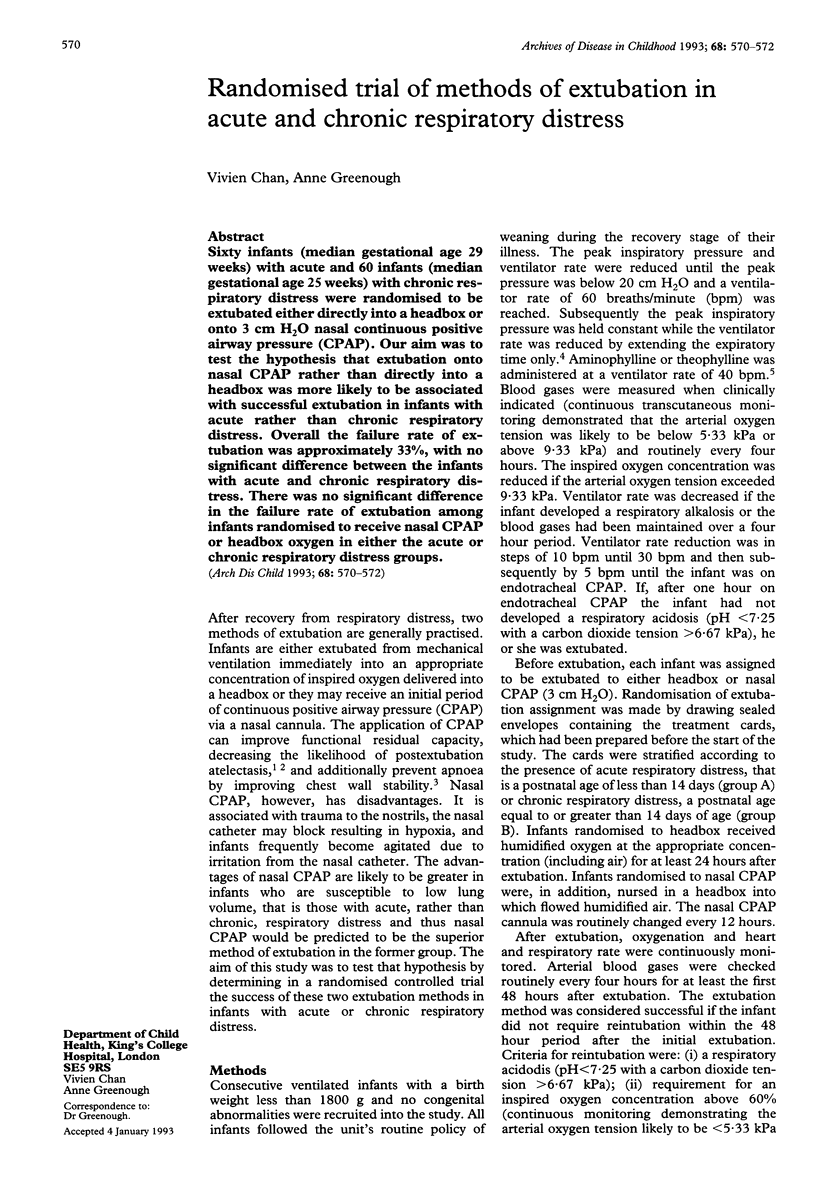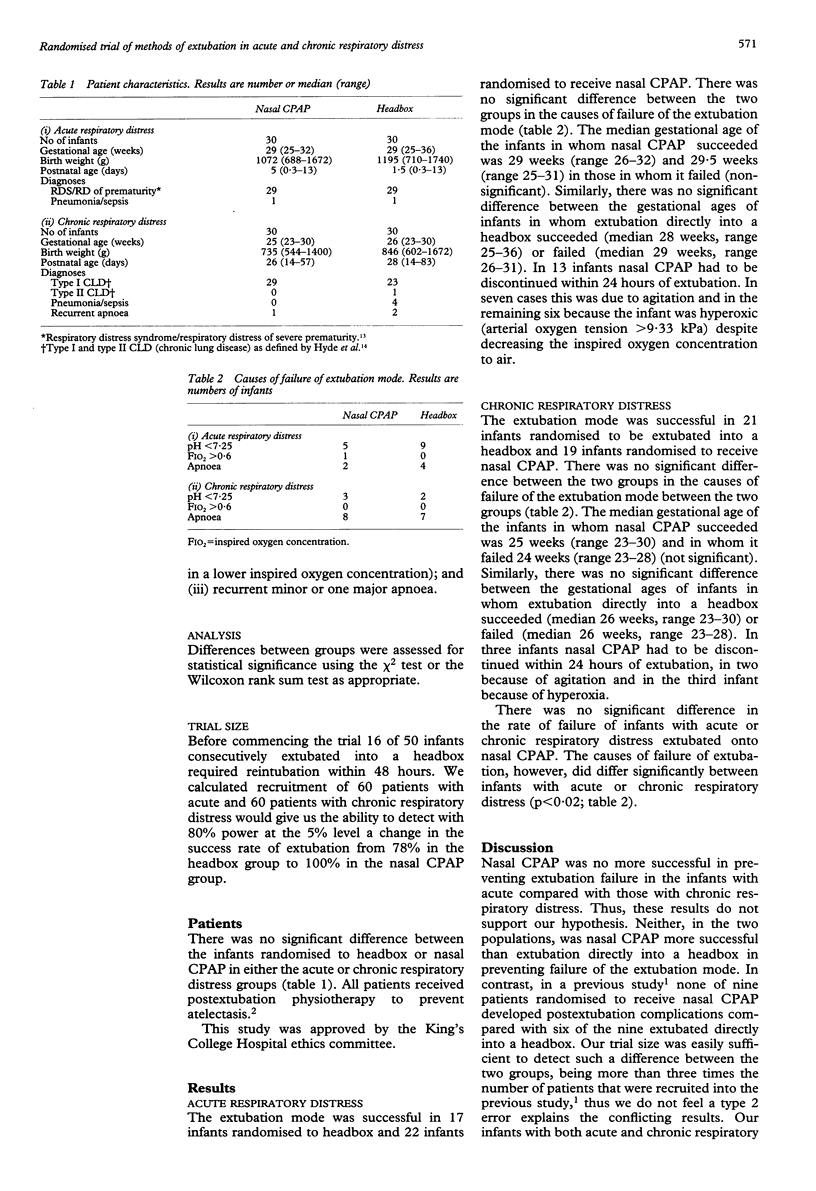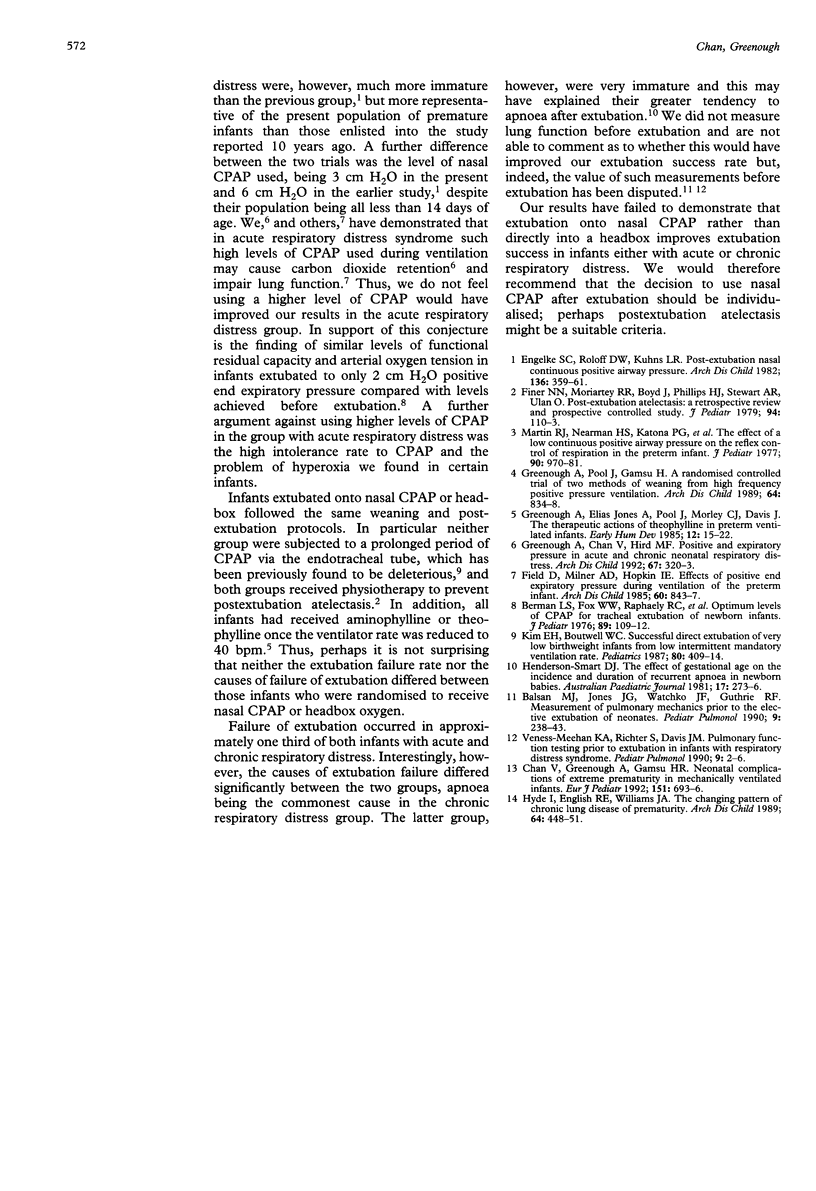Abstract
Sixty infants (median gestational age 29 weeks) with acute and 60 infants (median gestational age 25 weeks) with chronic respiratory distress were randomised to be extubated either directly into a headbox or onto 3 cm H2O nasal continuous positive airway pressure (CPAP). Our aim was to test the hypothesis that extubation onto nasal CPAP rather than directly into a headbox was more likely to be associated with successful extubation in infants with acute rather than chronic respiratory distress. Overall the failure rate of extubation was approximately 33%, with no significant difference between the infants with acute and chronic respiratory distress. There was no significant difference in the failure rate of extubation among infants randomised to receive nasal CPAP or headbox oxygen in either the acute or chronic respiratory distress groups.
Full text
PDF


Selected References
These references are in PubMed. This may not be the complete list of references from this article.
- Balsan M. J., Jones J. G., Watchko J. F., Guthrie R. D. Measurements of pulmonary mechanics prior to the elective extubation of neonates. Pediatr Pulmonol. 1990;9(4):238–243. doi: 10.1002/ppul.1950090409. [DOI] [PubMed] [Google Scholar]
- Berman L. S., Fox W. W., Raphaely R. C., Downes J. J., Jr Optimum levels of CPAP for tracheal extubation of newborn infants. J Pediatr. 1976 Jul;89(1):109–112. doi: 10.1016/s0022-3476(76)80942-0. [DOI] [PubMed] [Google Scholar]
- Chan V., Greenough A., Gamsu H. R. Neonatal complications of extreme prematurity in mechanically ventilated infants. Eur J Pediatr. 1992 Sep;151(9):693–696. doi: 10.1007/BF01957576. [DOI] [PubMed] [Google Scholar]
- Engelke S. C., Roloff D. W., Kuhns L. R. Postextubation nasal continuous positive airway pressure. A prospective controlled study. Am J Dis Child. 1982 Apr;136(4):359–361. doi: 10.1001/archpedi.1982.03970400077020. [DOI] [PubMed] [Google Scholar]
- Field D., Milner A. D., Hopkin I. E. Effects of positive end expiratory pressure during ventilation of the preterm infant. Arch Dis Child. 1985 Sep;60(9):843–847. doi: 10.1136/adc.60.9.843. [DOI] [PMC free article] [PubMed] [Google Scholar]
- Finer N. N., Moriartey R. R., Boyd J., Phillips H. J., Stewart A. R., Ulan O. Postextubation atelectasis: a retrospective review and a prospective controlled study. J Pediatr. 1979 Jan;94(1):110–113. doi: 10.1016/s0022-3476(79)80371-6. [DOI] [PubMed] [Google Scholar]
- Greenough A., Chan V., Hird M. F. Positive end expiratory pressure in acute and chronic respiratory distress. Arch Dis Child. 1992 Mar;67(3):320–323. doi: 10.1136/adc.67.3.320. [DOI] [PMC free article] [PubMed] [Google Scholar]
- Greenough A., Elias-Jones A., Pool J., Morley C. J., Davis J. A. The therapeutic actions of theophylline in preterm ventilated infants. Early Hum Dev. 1985 Oct;12(1):15–22. doi: 10.1016/0378-3782(85)90132-x. [DOI] [PubMed] [Google Scholar]
- Greenough A., Pool J., Gamsu H. Randomised controlled trial of two methods of weaning from high frequency positive pressure ventilation. Arch Dis Child. 1989 Jun;64(6):834–838. doi: 10.1136/adc.64.6.834. [DOI] [PMC free article] [PubMed] [Google Scholar]
- Henderson-Smart D. J. The effect of gestational age on the incidence and duration of recurrent apnoea in newborn babies. Aust Paediatr J. 1981 Dec;17(4):273–276. doi: 10.1111/j.1440-1754.1981.tb01957.x. [DOI] [PubMed] [Google Scholar]
- Hyde I., English R. E., Williams J. D. The changing pattern of chronic lung disease of prematurity. Arch Dis Child. 1989 Apr;64(4 Spec No):448–451. doi: 10.1136/adc.64.4_spec_no.448. [DOI] [PMC free article] [PubMed] [Google Scholar]
- Kim E. H., Boutwell W. C. Successful direct extubation of very low birth weight infants from low intermittent mandatory ventilation rate. Pediatrics. 1987 Sep;80(3):409–414. [PubMed] [Google Scholar]
- Veness-Meehan K. A., Richter S., Davis J. M. Pulmonary function testing prior to extubation in infants with respiratory distress syndrome. Pediatr Pulmonol. 1990;9(1):2–6. doi: 10.1002/ppul.1950090103. [DOI] [PubMed] [Google Scholar]


